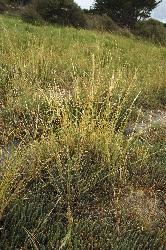- Taxon
- Gallery
- ≡ Glyceria stricta Hook.f., Bot. Antarct. Voy. II. (Fl. Nov.-Zel.) Part I, 304 (1853)
- ≡ Atropis stricta (Hook.f.) Hack. in Cheeseman, Man. New Zealand Fl. 914 (1906)
- = Poa syrtica F.Muell. (1855)
- ≡ Festuca syrtica (F.Muell.) F.Muell. (1873)
- ≡ Panicularia syrtica (F.Muell.) Kuntze (1891)
- = Glyceria tenuispica Steud. (1855)
- = Atropis stricta var. suborbicularis Hack. in Cheeseman, Man. New Zealand Fl. 915 (1906)
- ≡ Puccinellia stricta var. suborbicularis (Hack.) Allan & Jansen, Trans. Roy. Soc. New Zealand 69: 266 (1939)
- = Puccinellia stricta f. luxurians Allan & Jansen, Trans. Roy. Soc. New Zealand 69: 266 (1939)
- = Puccinellia stricta f. pumila Allan & Jansen, Trans. Roy. Soc. New Zealand 69: 266 (1939)
Light bluish green or rarely pale yellow-green perennial tufts, (2.5)–10–50–(65) cm, with stiff culms and leaves, or with finer and less rigid leaves; branching intravaginal. Leaf-sheath glabrous, submembranous to subcoriaceous, ± distinctly ribbed, light brownish to purplish. Ligule 0.7–1.5–(2) mm, glabrous, rounded to truncate, or ± tapered centrally and acute. Leaf-blade 1–12 cm ×c. 0.5 mm diam., involute, rigid and erect, or finer and softer, abaxially glabrous, adaxially sparsely scabrid on ribs, or sometimes densely scabrid throughout; margins scabrid, narrowed to fine acute tip. Culm (2)–5–20–(40) cm, erect, hidden by uppermost leaf-sheath at flowering, later visible, internodes glabrous. Panicle (2)–4.5–14.5–(20) × 0.2–5.5 cm, at first narrow-linear, racemose above, with few, erect, usually scabrid branches below, later more open with ± spreading branches naked below. Spikelets 3.5–9–(10.5) mm, 2–10-flowered, narrow, almost terete, light green to purplish. Glumes often quite unequal, elliptic-oblong, margins and sometimes midnerve minutely ciliate near apex; lower (0.6)–0.8–2.3 mm, 1-nerved, subacute to subobtuse, upper (1.3)–2–3.5 mm, 3-nerved, subobtuse to obtuse. Lemma (2)–2.5–3–(4) mm, 5-nerved, broad-elliptic, with very minute hairs at base not usually visible at ×10, and occasionally a few minute hairs on nerves near base, midnerve usually not quite reaching finely ciliate, obtuse apex. Palea ≤ lemma, apex bifid, keels scabrid in upper ⅔. Rachilla 0.5–1 mm. Anthers 0.4–1 mm. Caryopsis 1–1.8 × 0.4–0.7 mm.
[From: Edgar and Connor (2000) Flora of New Zealand. Volume 5 (second printing).]




